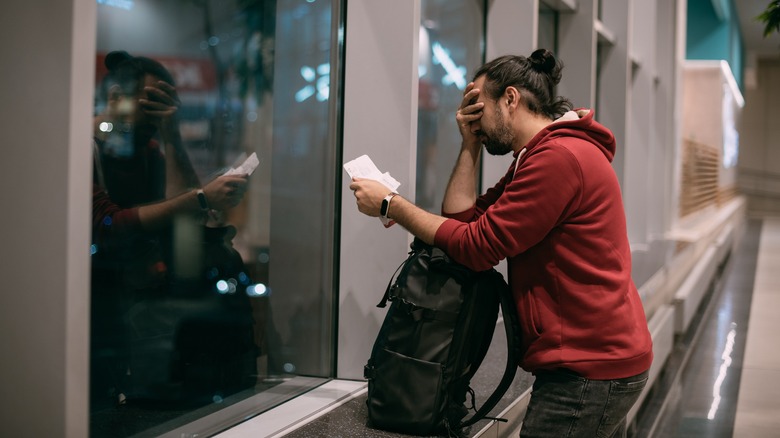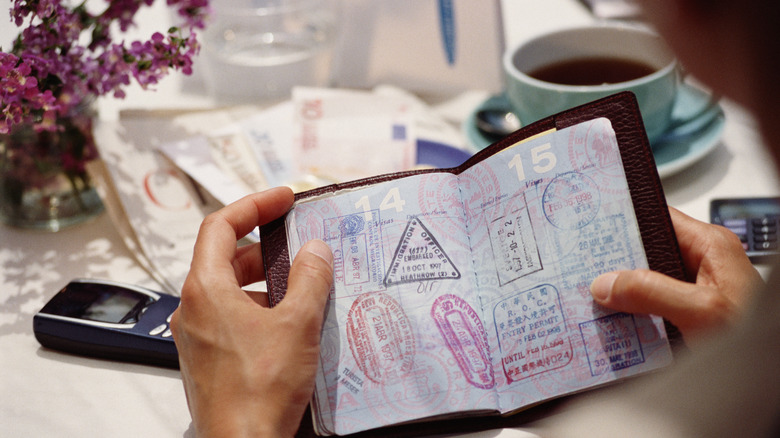Can You Still Fly With A Small Tear In Your Passport?
When you get to immigration after a 30-hour flight from New York to Tasmania, the last thing you want to say to a customs agent is, "My dog ate my passport." But what if Marmaduke really did sink his canines into a corner of it the night before the big trip? Can you still fly with a tear, and if so, how big of one?
According to the U.S. State Department, reasons for replacing a damaged passport include: "water damage; a significant tear; unofficial markings on the datapage; missing visa pages (torn out); a hole punch." This still leaves us with one burning, unanswered question: What constitutes a "significant" tear? Your guess is as good as ours, but it will ultimately be up to the individual customs agent, who might be having a bad day — maybe their dog ate their passport that morning — so replace it if you can.
It's best to apply for a passport nine months in advance. But if your flight is tomorrow and it's just a small tear, can you still travel? Probably. One Redditor reported successfully flying to Vietnam and India on a passport with a small tear where her dog had chewed on the corner (yep, it really does happen). But whatever you do, don't attempt to make any repairs, as that invalidates it immediately.
When you don't need to replace your passport
You should not replace your passport due to normal wear and tear. Is it bent into a curve from sitting in your back pocket throughout your junior year abroad? Are the visa pages permanently fanned out from opening and closing it a thousand times as you jetted from Paris to Patagonia to Portland? There's no need to replace it.
That said, you should treat it like an important document. Remember those "unofficial markings" the State Department mentioned? Never, ever let a tourist attraction put a souvenir stamp on your passport. Disneyland may be a Magic Kingdom, but it's not a country.
If you do need to replace yours before a trip, getting a passport re-issued can take up to eight weeks. You can get one faster by using a commercial expediter, but you should still plan on two weeks or more. If you're overseas when the damage occurs, you should contact the nearest embassy or consulate, and the good news is they can often replace your document faster than if you were at home, so a mishap with a spilled bottle of Chianti doesn't mean you'll be stranded in Italy for weeks — sorry to say.
How durable is your passport?
Passport technology is constantly evolving, but that doesn't always mean they're getting more durable. If your passport is relatively recent, it may have a polycarbonate datapage, the same material used to manufacture bulletproof glass. The purpose of the shift to this material is security, as the laminated layers can't be peeled apart by forgers. However, while it's extremely durable, this material is known to be less abrasion-resistant, so you should probably take even better care of your high-tech passport than you did your old paper one. Bulletproof? Yes. Scratch-proof? Not so much. Investing in a passport cover is a good idea.
As an issued passport is good for ten years, it's generally built to last, even as governments add technology like RFID chips, holograms, and invisible ink. Much like any consumer product where reliability is a factor, passport designs are put through stress tests (and no, "passport tester" is not a cool travel job you can apply for on Indeed — if only!). These are technical tests that involve processes like bending, pulling, and exposure to chemicals and UV light. So, that passport should hold up to the rigors of whatever style of travel you choose. Will your wallet hold up? Now that's another subject entirely.


